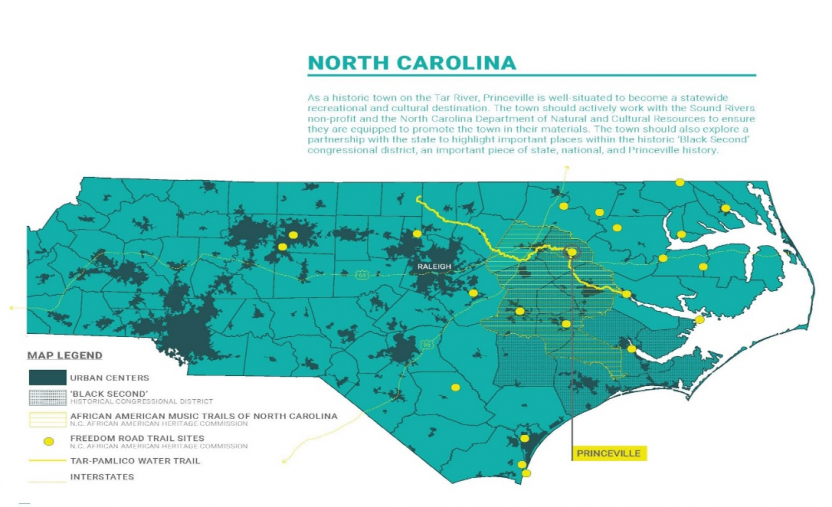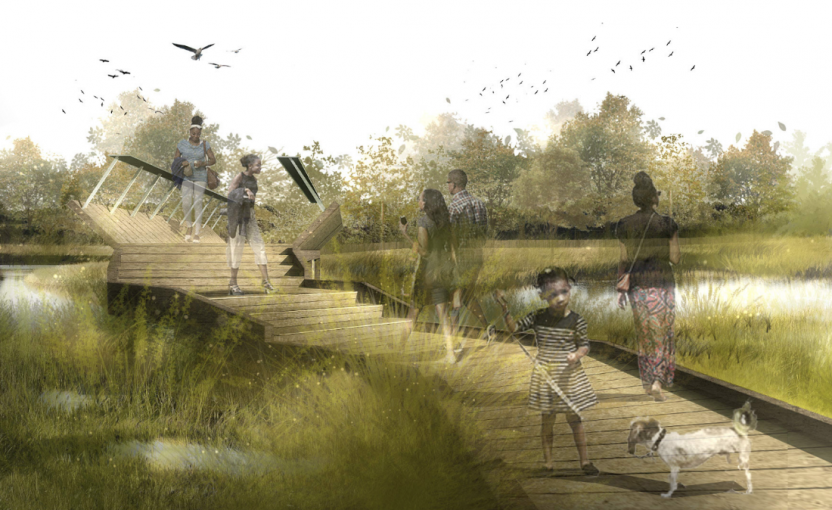Damaged by Hurricanes, a Historic North Carolina Town Plans for a Resilient Future
Undesirable Land, Unique History
Hurricane Matthew made landfall on October 8, 2016, resulting in massive floods across eastern North Carolina. Princeville was one of the many towns devastated by the storm; flooding left 80% of the town underwater. Its location within the Tar River’s floodplain makes it particularly vulnerable to severe damage, and Matthew marked the seventh debilitating flood the town has experienced since 1919. Just a few months ago, town officials and residents braced themselves for yet another monster storm but were spared when Hurricane Florence veered south.
Life in Princeville still has not returned to normal.
Princeville has gained national attention over the years because of recurring storm flooding, but it’s the town’s history that is most notable. Formerly enslaved people settled in Princeville after the Civil War in 1865, on land that white landowners deemed undesirable and were willing to sell. The town was incorporated in 1885, making Princeville the oldest incorporated Black town in the country.
It’s been more than 2 years since Hurricane Matthew, but Princeville is still dealing with repercussions from the storm. Life in Princeville still has not returned to normal. Students at Princeville Elementary are not expected to return to their school until fall of 2019, and municipal leaders currently operate from offices in the neighboring town of Tarboro.
Because the changing climate means that severe storms will continue to threaten the Southeast and Gulf coast regions, financial resources to respond to these disasters remain stretched and slow to be delivered. For instance, 18 months after Hurricane Matthew, only $40,000 of the $400 million in federal community development grants allocated to the State of North Carolina had been distributed to affected communities. In the wake of numerous recent natural disasters, it is imperative that the rebuilding needs of small and rural towns be considered. Considering the realities of small, low-wealth communities is especially critical because they often lack urban areas’ access to the human and financial resources needed for rebuilding, including ways to bridge the funding gaps over long periods of time that typify many recovery efforts and programs.
Preserving Princeville’s Culture
While the immediate threat has passed in Princeville, concern about maintaining community cohesion and character continues, given that resources are few and the potential for flooding is ever present. The process of building and rebuilding homes, businesses, and civic structures has been a common theme for generations in Princeville, which loses a piece of its rich history with each rebuilding effort. Recently, Princeville has taken important steps toward rebuilding the community beyond its physical structures. Community members are now focusing on preserving the culture and sense of place that makes Princeville home for long-term residents.
Since Hurricane Matthew, the North Carolina State College of Design’s Coastal Dynamics Design Lab (CDDL) has partnered with Princeville’s redevelopment team to explore design solutions that simultaneously celebrate Princeville’s history and prepare it for a more resilient future. This collaboration began with a CDDL-led research and engagement project entitled Homeplace. The resulting document was intended as a conversation guide to help flood survivors navigate the potentially confusing jargon and technical documents of local, state, and federal recovery policies and procedures.
Project partners all recognized that preserving and telling the story of Princeville’s past could play a key role in determining its future and catalyzing community-wide redevelopment.
The Homeplace project was quickly followed by the Princeville Community Design Workshop in August 2017. This event was developed and delivered in partnership with faculty members at North Carolina State University (NC State), the Coastal Resilience Center at The University of North Carolina at Chapel Hill, and North Carolina Emergency Management. The 5-day workshop included professional designers from across the country. Attendees focused on deep engagement with Princeville community members and stakeholders to hone and prioritize goals, challenges, and opportunities related to rebuilding. Project partners all recognized that preserving and telling the story of Princeville’s past could play a key role in determining its future and catalyzing community-wide redevelopment.
Princeville continues to seek historical recognition through local and federal agencies. This focus is more important than ever before because community members who hold the town’s stories and history continue to age, while historically significant places are increasingly vulnerable to environmental and economic threats. Most recently, Princeville has decided to establish the Princeville Heritage Walk to highlight remaining historical assets and — using the town’s landscape to organize and reveal its cultural narrative — ensure that visitors are able to understand Princeville’s past within its present circumstances.
Rich Past, Promising Future
Several students and faculty from NC State, with technical assistance from ChangeLab Solutions, worked with community members to design walking and biking routes, using the town’s existing pathways and sidewalk infrastructure to establish a network that directs residents and visitors through a series of culturally and environmentally significant sites. The trail network connects the oldest sites, including Shiloh Landing, where steamboats are believed to have delivered enslaved people, to the newest site, a 53-acre parcel outside of the 100-year floodplain that was recently annexed into the town limits to support essential services such as fire, police, and emergency medical services.
While the trail offers recreational opportunities for the community, it also serves as an interpretive timeline of Princeville’s story, linking its rich past to its promising future. With the recent confirmation of additional funding from the State of North Carolina and the North Carolina Community Foundation (NCCF), the NC State team is helping Princeville to design, fabricate, and install wayfinding and interpretive signage throughout the town. Initial project phases supported by the NCCF will be completed in spring of 2019, and state-funded portions will be completed in 3–5 years.
Even with the revived threats of the 2018 hurricane season, Princeville prevails. In this way, the town provides an example for the many small, rural towns that have been forced to rebuild in the aftermath of Hurricanes Florence and Michael. The recent projects highlight the value of community-led redevelopment efforts and historic preservation tactics that don’t often appear in the headlines and that FEMA dollars don’t typically cover. Princeville and its partners continue to push forward and find new ways to connect the past, present, and future of this resilient town.
________
By Virginia Fall, Andy Fox, & Lindsey Naylor
Learn more about the Princeville Heritage Walk project and the Princeville Community Design Workshop.
2/6/2019
Photographs curtesy of our Princeville Heritage Walk and Princeville Community Design Workshop

